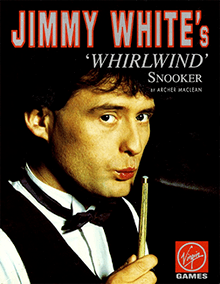Jimmy White's 'Whirlwind' Snooker
| Jimmy White's 'Whirlwind' Snooker | |
|---|---|
 | |
| Developer(s) | Archer MacLean |
| Publisher(s) | Virgin Games |
| Designer(s) | Archer MacLean |
| Composer(s) | Allister Brimble (Sega Mega Drive)[1] |
| Platform(s) | Amiga, Atari ST, PC, Sega Mega Drive |
| Release | 1991 |
| Genre(s) | Sports games (snooker) |
| Mode(s) | Single-player, multi-player |
Jimmy White's 'Whirlwind' Snooker is a computer game by veteran programmer Archer MacLean, released by Virgin Games in 1991 for the Commodore Amiga, Atari ST and PC (later for the Sega Mega Drive). 'Whirlwind' Snooker is a highly realistic snooker simulator.
Although the game was not the first to simulate snooker (or pool) in 3D, it made full use of the processing power and graphics capabilities of 16-bit home computers and was praised for its then ground-breaking realism and easy-to-use interface. ACE said that the game was the closest thing to being on a real snooker table which existed at the time, and it could be used by a player to refine real-life snooker skills.[2]
Development and technology
The game took MacLean several years to complete; the billiard ball physics alone taking several months of programming.[3] One of the reasons why the game runs as quickly as it does is the way in which each shot is played. The next shot is effectively pre-played while the white ball is being cued – the position and movement of each ball being calculated frame-by-frame and kept in a list in memory.
Each frame of the next shot is then displayed by rendering each ball from this list, frame-by-frame, instead of rendering it in real-time.[3] MacLean also explained that a closed environment like a snooker table allowed certain optimizations that would not be possible in 3D games such as Elite.[3]
Features

Despite being an accurate and serious simulation of the sport, MacLean's irreverent sense of humour was prominent throughout. The sound effect used for a successful pot was a resounding "pop" (regardless of the speed at which the ball reached the pocket) and numerous animations provided comic relief should a player take more than a few seconds to shoot. Balls would sprout eyeballs and arms, making faces at the player or holding up signs that read "Get on with it!" and such.
Also present was an extensive trick shot editor, featuring a number of pre-set table arrangements with instructions on how they should be played. An easter egg enabled the option to watch the computer player complete a maximum break. The game's title music was similar to (and probably intended to pay homage to) that of snooker TV programme Pot Black.
The game featured a copy protection mechanism in which the user was prompted to enter a word from the manual corresponding to a certain page, paragraph and word number. Getting this word wrong three times caused the word FAIL to appear over the screen many times (after which, in the PC version, the computer was rebooted).
Tournament
Following the game's release, Virgin launched a nationwide tournament in the UK. Regional heats were held at Virgin's stores; the eventual winner went on to challenge MacLean himself in the first series of Channel 4's GamesMaster with snooker pro Jimmy White commentating.[4] The game itself would also appear on two further episodes of GamesMaster, with John Parrott appearing on the second series,[5] and Jimmy White himself playing the game in Series 4.[6]
Sequels
The game was followed by Archer MacLean's Pool in 1992, Jimmy White's 2: Cueball in 1999 and Jimmy White's Cueball World in 2001.
Reception
| Reception | ||||||||||||||||||
|---|---|---|---|---|---|---|---|---|---|---|---|---|---|---|---|---|---|---|
| ||||||||||||||||||
Critical Reception for the game was generally high.[8] Video game aggregator website Game Rankings scored the game at 80%.[7] UK Magazine Mean Sega Machines scored the game highly, with 92%, particularly enjoying the game's pick-up and play controls, and the accurate portrayal of Snooker, saying "JWWS brings simulation into the 90s, and is destined to be the benchmark other sims are measured by."[8]
In 1994, PC Gamer UK named Whirlwind Snooker the 37th best computer game of all time.[12]
References
- ↑ "Allister Bromble Portfolio" (PDF). Archived (PDF) from the original on 11 December 2017. Retrieved 11 January 2018.
- ↑ "ACE benchmarks", ACE (50), p. 48, November 1991 )
- 1 2 3 Liddon, Gary (November 1990), "A dream come true", The One (26), pp. 48–49, archived from the original on 31 July 2016
- ↑ "GamesMaster Episode 1, Series 4". 1. Series 4. 7 January 1992. Archived from the original on 11 January 2018. Retrieved 11 January 2018.
- ↑ "GamesMaster Episode 2, Series 9". 9. Series 2. 26 November 1992. Archived from the original on 11 January 2018. Retrieved 11 January 2018.
- ↑ "GamesMaster Episode 3, Series 4". 3. Series 4. 4 October 1994. Archived from the original on 11 January 2018. Retrieved 11 January 2018.
- 1 2 "Jimmy White's Whirlwind Snooker". Game Rankings. Archived from the original on 11 January 2018. Retrieved 11 January 2018.
- 1 2 3 "Jimmy White's Whirlwind Snooker" (PDF). Mean Machines (Sega) (26): 100–101. Archived (PDF) from the original on 3 April 2018.
- ↑ "Jimmy White review - Sega Power". Sega Power (61): 75.
- ↑ "Jimmy White's Whirlwind Review". Sega Pro Magazine (39): 46–47.
- ↑ "Jimmy White Whirlwind Snooker Review". Ultimate Future Games. 1: 127.
- ↑ Staff (April 1994). "The PC Gamer Top 50 PC Games of All Time". PC Gamer UK (5): 43–56.
HoL Team (4 November 2007). "Jimmy White's 'Whirlwind' Snooker". Hall of Light: The Database of Amiga Games. pp. Games Listing. Retrieved 14 August 2008.